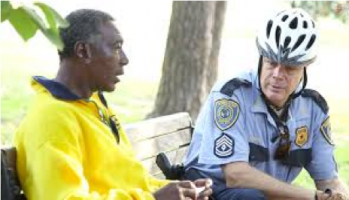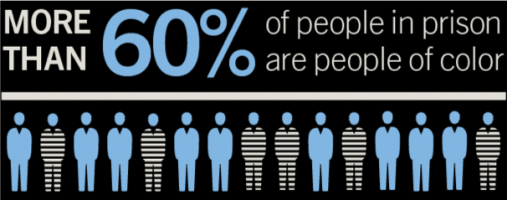The Police & You: A Dynamic Duo for a Better Today, Tomorrow & Forever
The views expressed are those of the author and do not necessarily reflect the views of ASPA as an organization.
By Tosha Wilson-Davis
July 20, 2019

To serve and protect. All citizens are familiar with this phrase. It is the ultimate mission for all law enforcement officers. Yet, in recent years there seems to be some confusion on whether law enforcement officers work for and with all or just the select few. Based on quantifiable evidence, there are different attitudes between minorities and non-minorities about our criminal justice system and what it stands for.
According to Public Religion Research Institute, there are about four in ten people in the United States who agree that African Americans receive equal treatment compared to their white counterparts. Only 17 percent of black Americans agree, while 78 percent disagree that they receive equal treatment to white people as it relates to law enforcement and the criminal justice system. This is compared with white Americans, where 46 percent agree and 47 percent disagree.
So, what are some things that may contribute to the differing viewpoints, considering law enforcement officers are expected to serve as neutral protectants of the law? Perhaps, higher incidences of African Americans being stopped by the police, longer sentences given to African Americans compared to white people for the same drug offenses, and the unequal application of the death penalty imposed on African Americans, just to name a few. Yet, the list continues.

According to a 2015 study by the Sentencing Project, “Implicit racial bias leads criminal justice practitioners to punish people of color more severely than whites, and resource allocation decisions disadvantage low-income defendants, who are disproportionately people of color.” Sadly, it seems to be a vicious cycle. Furthermore, a 2016 study further exemplifies the racial disparity within the criminal justice system, asserting that, “African Americans are incarcerated in state prisons across the country at more than five times the rate of whites, and at least ten times the rate in five states.”
It is safe to conclude that policing in America is facing a huge crisis of validity and purpose. There must be some resolve to bring back the trust between minority citizens and law enforcement. Many still remember the famous ChiPs TV show. Although we know such shows were storylines, the gist and main idea remain—both law enforcement officers and their respective authority were simple, firm, genuine and neutral. Such characteristics have been lost in recent years, resulting in ruptured and spoiled relations between police and the communities they serve, particularly communities of color.
Therefore, law enforcement and leaders within the community must find creative ways to bring back genuine, unbiased policing that serve all communities in a fair and effective manner. They must consistently research ways to implement programs and policies that are more focused on community-oriented policing. The U.S. Department of Justice states that community-oriented policing, “Begins with a commitment to building trust and mutual respect between police and the communities they serve. When police and communities collaborate, they more effectively address underlying issues, change negative behavioral patterns, and allocate resources.”
So how can communities jump on the COPS bandwagon? Contacting one’s local law enforcement precinct and bringing in other community leaders, such as business owners, public school leadership and religious leaders for quarterly town hall meetings and seminars with citizens would be a great start. Also, a visit from law enforcement to the local school districts once a month to talk with students about the work they do provides a positive message to them and can ease the tension that some minority youth may have about police officers. Starting early is key and reduces the apprehension minority youth may have once they encounter a police officer.
It is also worth noting that police departments must diversify their workforce and internal processes, including recruiting and promotions, to make sure they are fair and transparent. Doing so creates an environment that is representative of the communities they serve and a landscape of respect that officers carry with them during their daily interactions with the community.
In essence, utilization of community-oriented policing eventually helps build a bridge that both the police and the community can cross together. It’s a partnership! There is less of an attitude that resembles, “Them against us,” yet, both parties assemble a more collaborative and proactive approach to fight crime together, creating unified, restored and safer communities.
Author:
Tosha Wilson-Davis, MPA, MSCJ
Justice Studies Department Chair/Assistant Professor of Criminal Justice
Georgia Military College-Online Campus
[email protected]




 (5 votes, average: 5.00 out of 5)
(5 votes, average: 5.00 out of 5)
 Loading...
Loading...
The Police & You: A Dynamic Duo for a Better Today, Tomorrow & Forever
The views expressed are those of the author and do not necessarily reflect the views of ASPA as an organization.
By Tosha Wilson-Davis
July 20, 2019
To serve and protect. All citizens are familiar with this phrase. It is the ultimate mission for all law enforcement officers. Yet, in recent years there seems to be some confusion on whether law enforcement officers work for and with all or just the select few. Based on quantifiable evidence, there are different attitudes between minorities and non-minorities about our criminal justice system and what it stands for.
According to Public Religion Research Institute, there are about four in ten people in the United States who agree that African Americans receive equal treatment compared to their white counterparts. Only 17 percent of black Americans agree, while 78 percent disagree that they receive equal treatment to white people as it relates to law enforcement and the criminal justice system. This is compared with white Americans, where 46 percent agree and 47 percent disagree.
So, what are some things that may contribute to the differing viewpoints, considering law enforcement officers are expected to serve as neutral protectants of the law? Perhaps, higher incidences of African Americans being stopped by the police, longer sentences given to African Americans compared to white people for the same drug offenses, and the unequal application of the death penalty imposed on African Americans, just to name a few. Yet, the list continues.
According to a 2015 study by the Sentencing Project, “Implicit racial bias leads criminal justice practitioners to punish people of color more severely than whites, and resource allocation decisions disadvantage low-income defendants, who are disproportionately people of color.” Sadly, it seems to be a vicious cycle. Furthermore, a 2016 study further exemplifies the racial disparity within the criminal justice system, asserting that, “African Americans are incarcerated in state prisons across the country at more than five times the rate of whites, and at least ten times the rate in five states.”
It is safe to conclude that policing in America is facing a huge crisis of validity and purpose. There must be some resolve to bring back the trust between minority citizens and law enforcement. Many still remember the famous ChiPs TV show. Although we know such shows were storylines, the gist and main idea remain—both law enforcement officers and their respective authority were simple, firm, genuine and neutral. Such characteristics have been lost in recent years, resulting in ruptured and spoiled relations between police and the communities they serve, particularly communities of color.
Therefore, law enforcement and leaders within the community must find creative ways to bring back genuine, unbiased policing that serve all communities in a fair and effective manner. They must consistently research ways to implement programs and policies that are more focused on community-oriented policing. The U.S. Department of Justice states that community-oriented policing, “Begins with a commitment to building trust and mutual respect between police and the communities they serve. When police and communities collaborate, they more effectively address underlying issues, change negative behavioral patterns, and allocate resources.”
So how can communities jump on the COPS bandwagon? Contacting one’s local law enforcement precinct and bringing in other community leaders, such as business owners, public school leadership and religious leaders for quarterly town hall meetings and seminars with citizens would be a great start. Also, a visit from law enforcement to the local school districts once a month to talk with students about the work they do provides a positive message to them and can ease the tension that some minority youth may have about police officers. Starting early is key and reduces the apprehension minority youth may have once they encounter a police officer.
It is also worth noting that police departments must diversify their workforce and internal processes, including recruiting and promotions, to make sure they are fair and transparent. Doing so creates an environment that is representative of the communities they serve and a landscape of respect that officers carry with them during their daily interactions with the community.
In essence, utilization of community-oriented policing eventually helps build a bridge that both the police and the community can cross together. It’s a partnership! There is less of an attitude that resembles, “Them against us,” yet, both parties assemble a more collaborative and proactive approach to fight crime together, creating unified, restored and safer communities.
Author:
Tosha Wilson-Davis, MPA, MSCJ
Justice Studies Department Chair/Assistant Professor of Criminal Justice
Georgia Military College-Online Campus
[email protected]
Follow Us!